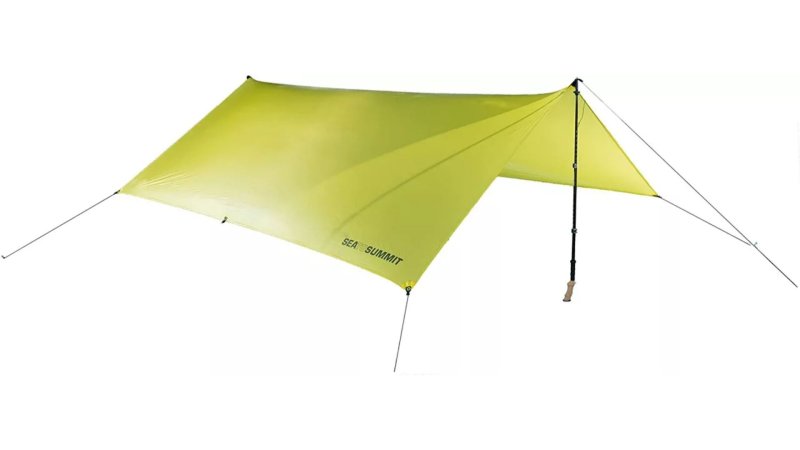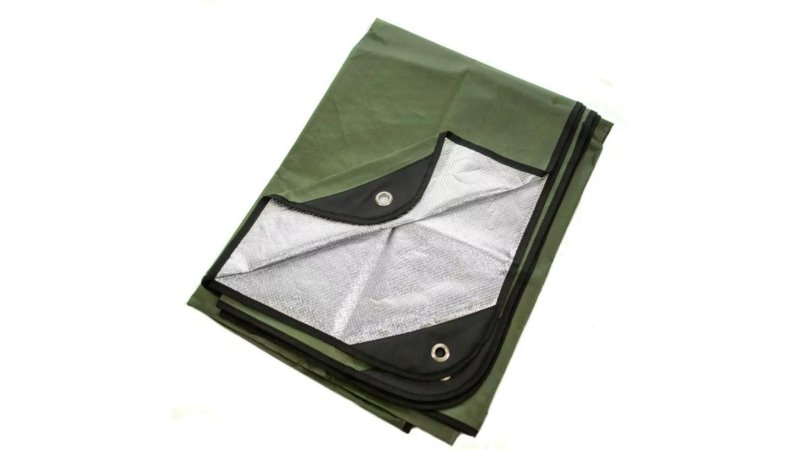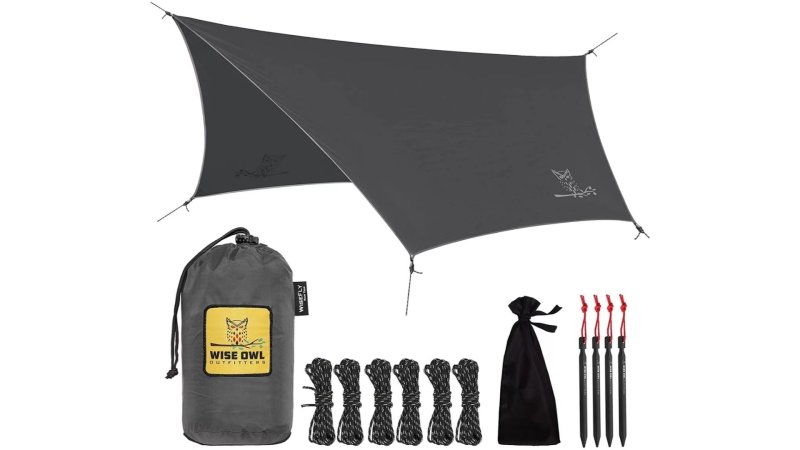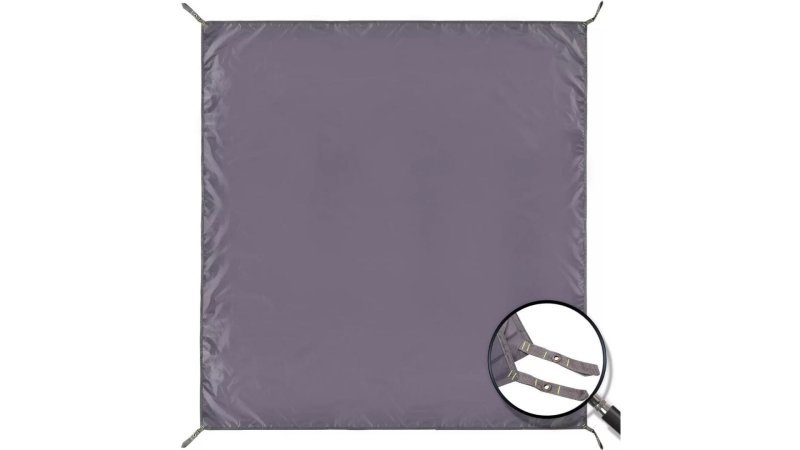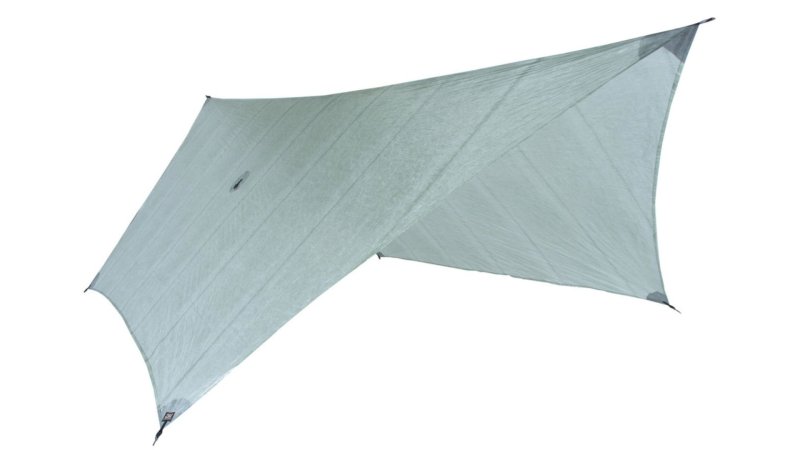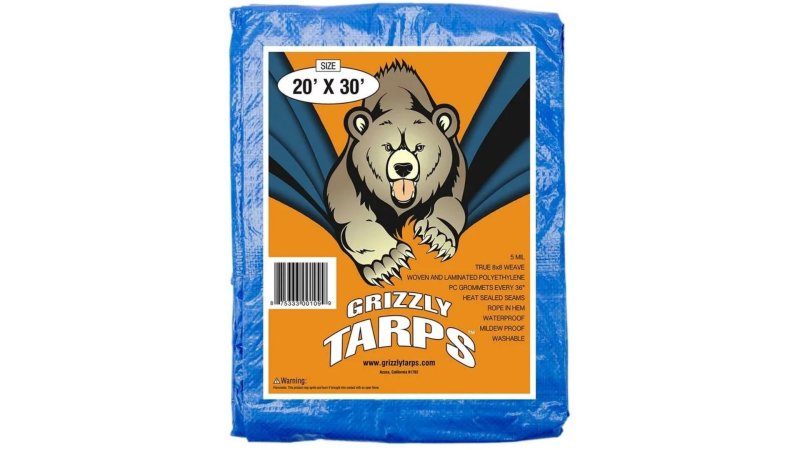

We may earn revenue from the products available on this page and participate in affiliate programs.
If I had a nickel for every time someone asked for my thoughts on the market’s best camping tarps, I’d have —well — no nickels. Unfortunately (and unwisely), camping tarps are often a piece of equipment that gets minimal dedicated thought, which is curious because a good camping tarp can be the difference between a good, all-weather camping trip and a cold, wet, miserable time. In Michigan, we have a saying: “Don’t like the weather? Wait five minutes and it’ll change.” This may be a saying in other places too, but it was obviously stolen from us. The point is, if you’re going to spend some time in the wilderness, you best be prepared for what Mother Nature has to throw at you.
I learned this first-hand in my Army-tomfoolery and over several decades of backwoods camping, but on occasion drove home this point more so than last year’s annual camping trip to the Pine River in mid-Michigan. For five days, it did nothing but rain and our campsite was transformed into a “tarp city” with big sheets of waterproof canvas tied off in all directions to protect our hammocks, tents, and cooking gear. Some of our tarps were good. Some were not. Either way, I quickly learned the importance of this, sometimes overlooked, piece of camping gear.
In the sections below, I’ll provide a list of recommendations for the best camping tarps available, and their recommended uses. I’ll also talk about some of the key attributes you’ll want to look for when making your purchase. Hopefully, you’ll walk away with a newfound respect for this simple piece of gear and you’ll stay nice and dry on your next trip to the woods.
Best Overall
Sea To Summit Escapist Tarp
Pros
- Extremely lightweightt
- Durable fabric
- Waterproof
Cons
- Only one color option
Product Specs
- Dimensions: 10 x 10 feet
- Weight: 15.5 ounces
- Material: Ultra-sil nano nylon (15 denier)
Best Value
Arcturus Heavy Duty Insulated Thermal Reflective Tarp
Pros
- Mylar reflective surface reflects light or retains heat
- Reinforced tie-down grommets
- Waterproof
Cons
- May be a bit short for hammock campers
Product Specs
- Dimensions: 60 x 82 inches
- Weight: 1.4 pounds
- Material: Layered polypropylene
Editor’s Choice
Wise Owl Outfitters Hammock Tarp
Pros
- Extremely waterproof
- Comes with tent stakes and guylines
- Lightweight despite denser material
Cons
- Hammock tarp/not versatile
- Only one color option in stock
Product Specs
- Dimensions: 108 x 132 inches (9 x 11 feet)
- Weight: 18.9 ounces
- Material: 210T nylon ripstop fabric
Best for Tent Camping
Redcamp Waterproof Camping Tarp
Pros
- Waterproof classification: PU1000MM
- Highly durable fabric
- Lightweight
Cons
- Only available in gray
- Thicker fabric means it requires more space in your backpack
- Only four grommets for tie-downs
Product Specs
- Dimensions: 36 x 83 inches (smallest) / 118 x 165 inches (largest)
- Weight: 0.5 pounds (smallest) / 2.9 pounds (largest)
- Material: 210D Oxford ripstop fabric
Best for Thru-Hiking
Dyneema Fiber Hex Tarp
Pros
- Extremely lightweight and compact
- Highly durable fabric
- Waterproof
Cons
- Material does not stretch, which can cause problems in high wind
- Made primarily for hammock camping/not very versatile
- High price
Product Specs
- Dimensions: 104 x 144 inches
- Weight: 5.14 ounces
- Material: Dyneema composite fabric
Best for Bigger Groups
B-Air Grizzly Tarps
Pros
- Available in large sizes
- Durable/waterproof material
- Grommets every 36 inches
- Low cost
Cons
- Bulky and cumbersome
- Heavy compared to hiking tarps
Product Specs
- Dimensions: 6 x 8 feet (smallest) / 20 x 30 feet (largest) (many sizes in between)
- Weight: 9.6 ounces (smallest) / 9.58 pounds (largest)
- Material: Woven polyethylene
Why you should trust us
Every year, I take a trip to the Pine River here in Michigan with several old friends, and every year we seem to get hit with at least a little bit of rain. Last year, however, it rained — hard — for the majority of the five-day trip. The trip could have easily turned into a miserable experience, but it ended up being one of the best years we’ve had, largely because of the construction of our “tarp city” that kept us dry and protected from the winds. We had tarps strung all over, creating seating areas, kitchen areas, and sleeping areas. The tarps, quite literally, salvaged the camping trip. So if you’re wondering why you should trust my opinion on camping tarps, like Farmers Insurance, “I know a thing or two because I’ve seen a thing or two”.
Types of camping tarps
Before I launch into some different types of tarps, let me preface this section by acknowledging that most, if not all tarps, can serve multiple duties in a pinch.
Shelter tarp
Any tarp with tie-out points or grommets can be used as a shelter in a pinch, though some are better equipped than others. The best shelter tarps are going to be lightweight, with a high waterproof rating. Heavy tarps can be difficult to string up between trees, and their excess weight creates sagging at the center, which inevitably turns into a collection point for rainwater. Shelter tarps must also be extremely durable, as they need to be able to stand up to high winds. This goes for both the tarp fabric itself and the tie-out points. There’s nothing worse than a tie-out point snapping on you during the middle of a rainstorm.
Ground tarp
A ground tarp is a tarp you might lay out underneath your tent in order to protect it from ground moisture and other debris on your campsite. A good ground tent must be highly durable since you’re going to be treading on it and it’s going to get poked by all the sticks, rocks, and roots you were too tired or lazy to clear out before erecting your tent. If you’re not hiking far, a nice thick, heavy tarp can also add a layer of cushion between you and the ground beneath your tent.
Hammock tarp
Hammock camping has become a big trend and outfitters are now making tarps specifically for hammock campers. Most rectangular tarps can be rigged in an A-frame configuration to provide shelter for a hammock, but some tarps are now being designed specifically for hammocking (yes, it’s a verb now). Hammock tarps typically have longer ridgelines (centerline) with sides that sweep back into tie-out points. This allows for all the necessary rain and wind protection for the hammock while minimizing the tarp size and weight. As a hammock camper myself, I can tell you that durable material is a must. I’ve been caught in more than a few windstorms and have been amazed at the beating some of those tarps can take.
Key features of camping tarps
Fabric
There are a lot of different fabrics used in camping tarps and, frankly, keeping all their synthetic names straight can be quite a task. The primary feature you’re looking for in a camping tarp’s fabric is going to be durability (I’ll cover waterproofing in a minute). Durability can come in a lot of different forms, depending on the fabric’s composition. For tarps that use actual woven threads, you’ll want to keep an eye on the Denier number, which is a unit of measurement for the fiber thickness, or the “T number,” which is the number of yarns in one square inch of fabric. For tarps that use sheets of composite materials, you’ll want to pay attention to the tarp’s elasticity. Many of these tarps offer very little stretch, so you’ll want to add measures like “shock loops” to your tie-out points to prevent damage.
Waterproof
This is probably more of a subcategory of the fabric section, as most tarps are marketed as waterproof, though the means by which they attain the status is as varied as the fabric types. Whether something is waterproof or not seems like it should be rather (I’m sorry) cut and dry. It either keeps water out or it doesn’t, right? Wrong. Here’s why. For tarps being used as shelters, you want the fabric to also be light and breathable, as suffocation will put a damper on your camping weekend. Making a fabric waterproof, while also keeping it light and breathable, is a tricky dance, and a rating system has been developed to categorize a fabric’s level of waterproofness (not a real word). The PU rating of a tarp fabric will be a good indicator of how well the tarp can hold out water (PU is the designation that a polyurethane coating has been applied to the fabric). The rating is generally a large number followed by “MM.” This indicates the number of millimeters of water (at a one-inch diameter) the fabric can hold back for at least one minute before a single drop passes through. The minimum rating to be considered waterproof is PU 1000MM.
Tie-out points
Tie-out points are another important aspect of a camping tarp if you intend to use the tarp for shelter. The two most common types of tie-out points are aluminum (or other lightweight metal) grommets or heavy-duty fabric straps, which are usually double-stitched into the corners of the tarp. Whatever you choose, make sure it’s tough. A good, strong wind can turn your A-frame tarp setup into a sail and snap your tie-out points like they’re nothing.
Benefits of camping tarps
Shelter
Protection from the elements is something all humans need, and if you’re out camping or hiking, you want that protection to be as portable as possible. Camping tarps make great shelters because they are lightweight, compact (most of them), and durable. With a few guylines, tent stakes, or just a bundle of paracord, almost any camping tarp can be turned into an A-frame, lean-to, or any other number of shelter configurations.
Moisture barrier
If the water doesn’t get you from above, it’ll try to get you from the ground. Having a good, waterproof tarp to go under your tent is a smart choice and can keep you from waking up with gear wet from water soaked through your tent floor.
Survival
Whether you think you’ll need it or not, it’s always a good idea to have a camping tarp with you on any excursion into the woods. Weather can often change, and change fast. When this happens, you want to be equipped with at least a basic shelter option. In more extreme circumstances a brightly colored camping tarp can be a good way to signal someone if you are lost or in distress out on the trail. Some camping tarps even feature one side of Mylar coating to help retain heat, reflect sunlight, or enhance signaling capabilities.
Pricing considerations for camping tarps
Budget
You’ll find most of your basic level, generic tarps (of the small to moderate size range) under $25. These tarps are good for camping where you don’t have to hike your gear very far, as they are often heavy and cumbersome to carry. They work great as ground tarps (for tents) or as lean-to tarps for protection from wind and rain. At the top of this price range, you’ll start to see some basic model hammock tarps, but be sure to scrutinize the fabric type and waterproof ratings.
Mid-range
Between $25 and $75, you’ll start to see lightweight tarps for more rustic camping, but again you’ll want to be mindful of your fabric choice and your waterproof ratings. Many of the tarps in this price range start to come equipped with stuff sacks, tent stakes, and guylines, which are a nice extra and prevent you from having to make multiple purchases. This is also where you’ll find some of the huge tarps in the “general tarp” category, which can be good for crafting shelters for larger groups of people.
Premium
Over $75 is where you start to get into your higher-end tarps, for the more serious and well-funded hikers and campers. The tarps in this range will tend to be ultra-light and highly durable, with high waterproof ratings. While these tarps are great, keep in mind that this is an item whose sole purpose is to be a barrier between you and the elements, meaning it’s taking all the punishment. Before you take your expensive tarp out to the woods, be sure you’re well-versed in proper tie-out techniques and equipment care.
How we chose our top picks
I chose my top camping tarps through extensive research, which I pitted against over 20 years of my own experiences in backwoods camping. I also scoured top picks made by other online camping enthusiasts and scoured the reviews of tarps with a wide variety of designs and builds. Over the years I, and my friends, have used a wide array of camping tarps for tent coverings, hammock shelters, and lean-tos. We’ve pitted them against some pretty severe weather, so I feel confident in knowing what aspects are most important and I made my choices based on what I would most like to use when out in the field.
FAQs on camping tarps
You’ve got questions, Task & Purpose has answers.
Q: What size tarp do I need?
A: This depends on intent. For individual A-frames, you can get by with something small, like a 6 x 8 foot tarp. If you are looking to cover a cooking area or create a communal space for several people, aim for something much bigger.
Q: Should I put a tarp under my tent?
A: Sure. A tarp under your tent will create a barrier between you and the ground. It’s the same logic as wearing underwear under your pants. You don’t have to, but you’d probably be more comfortable if you did.
Q: How do you keep a camping tarp dry?
A: You don’t. It keeps you dry. That’s the point. (After camping trips, I usually string up my gear in my garage to let it air out for a day or two).
Q: Can I use a tarp as a rain fly?
A: Yes, but keep in mind the breathability of the tarp and the spacing over the tarp. A thick tarp placed too low can make your tent stuffy and unbearable in a hurry.
